|
Design Page Over the years, I've come to realize that no one person, no one manufacturer can design, build and sell what everyone wants in or on a plane. Each person has individual desires that lead them to wanting different features, accessories, whatever. I am no different. I like neat stuff that is functional, robust in design, has a reasonable cost and can be repaired by the average person. The following photos will show the many design innovations that have been done locally to the Quicksilver line of aircraft. One of the first design changes I did was to install a larger prop
on the MX series, the MX, MXL, MXII and the MX Super. The increase
to 66 inches or even larger requires moving the tail booms out nine
inches. Also, the push/pull tube must be moved and pivoted on the rear
axle for prop clearance. Shown here are pictures of an MXII with a
66 inch prop. The second shows a rear view including the detail of
the overhead wire guard. This guard allows the top tail wires, which
greatly stiffen the airframe, to be retained .Note that this guard
is bolted into the original tail boom bolt holes. 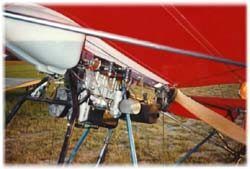 
Another neat change I made to my first MX II trainer plane. I had great funm giving people rides and teaching them to fly. But ground handling was a bit scary requiring full throttle, full rudder, and prayer or two to do a 180 after landing. To lesson the fear factor of taxiing, I created a steerable nosewheel, and I think it may be the first ever on a Quicksilver. I layed out a large sheet of rather thin material with a complcated design. The whole thing folded into a box with space for two cross tubes, adn the front steerable gooseneck mounting taken from a bicycle frame shop. I added two upper nose struts to take the bending of the extended wheel, and widened the bike fork for the standard Quicksilver plastic wheel by heating and bending the steel fork. Control was by cables from the lower end of the control stick which allowed both me and the student to have steering. It worked very well, and is still on the plane today, twenty years later. A careful look will show the added nose struts and the pedals mounted on the higher set. Details of the actual shaped welded piece are not available. 
One of the first really functional designs was done to a copy of the Quicksilver called a "Phoenix". The Phoenix was brought to the market just following the downfall, the first downfall, of the Quicksilver company.These pictures show the Phoenix with a full enclosure. Top speed was over 60 mph. The small Rotax 277 had only 20 some horsepower but was quite the engine for this speed, especially with with a full length, single surface wing.  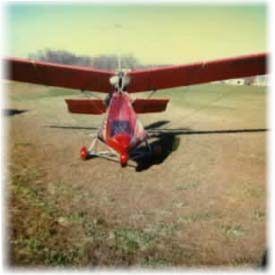
We often built planes that we wanted too, not just for customers. This next plane was sort of a concept plane to design the some different pedals, a yoke aileron control and a pedal operated toe brake system. Two out of three worked very well. The toe brake was very hard to operate and steer at the same time. Actually, we had a minor tube bending problem before the plane left the ground due to the brakes. Shown below are pictures of the pretty lime green Sport with the yoke steering, the rotating pedals and the toe brakes located at the top of the pivoting pedals.
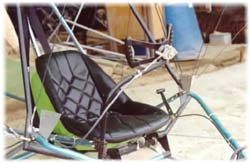 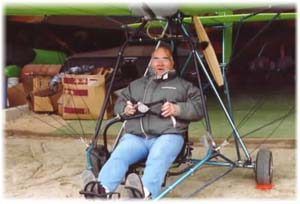
Another innovation for this series of plane was the design of lower degree wire sets. These wire sets allowed the dihedral to be reduced from the high MX and the 1/2 MX dihedral of the MXL to almost none. Shown are planes with very low dihedral wire sets.
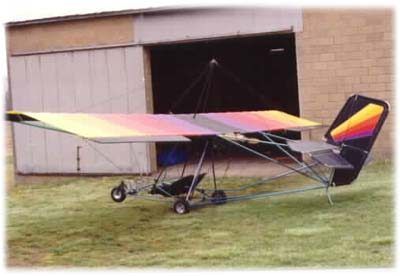 
One rather neat project for a special customer was a set of flaps on his MXL. The resulting flap design worked very well but the effectiveness of the flaps was not the best until some airspeed was attained. Since they are not directly behingd the prop blast, they only see airspeed. Shown here is the skeleton of the MXL while the design details of the flap system were worked out.
 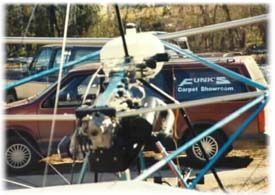
Shown below are two small design mods which have worked very well. The first two pictures show a muffler mount which done very well. The third shows the hand brake lever which replaced the ill-fated toe brake pedals.
  
I have always admired the Ultrameter gauge. It is very resistant to vibration which is an attribute for the UL market. Another good feature is that it is very accurate. I even liked it so much, I bought the company! Shown below is the Ultrameter and the heavy front fork I make to allow installation of a 4 by 6 Hegar or similar wheel on the front of a Quick.
 
One of the largest projects that ever got started and never finished is the amphibious plane using the GT 400 wings and tail group. It is fiberglass and the wheels retract into the front and sides of the large single float. Finishing this one will probably take more time than I have available for it. Shown are a couple of shots showing the project as it stands now.
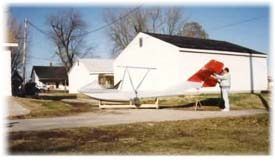 
The most recent project is the relocation of the motor. It started on top of the wing just behind the kingpost and has ended up at the rear of the root tube under the wing. Some people see the plane and say that's where it should have been in the first place.  
Other projects include aileron pushrods replacing the cables, rod ends replacing the high wear items such as the elevator horn, the aileron horns, the stick controls, and even large projects such as a project plane designed and built to meet the weight limits of FAR 103. I hope these pictures have enlightened you about the projects going on at Tri-State Kite Sales. There are always new things to do, new things to be developed and new ideas which need testing. We will be there doing just that!
|
